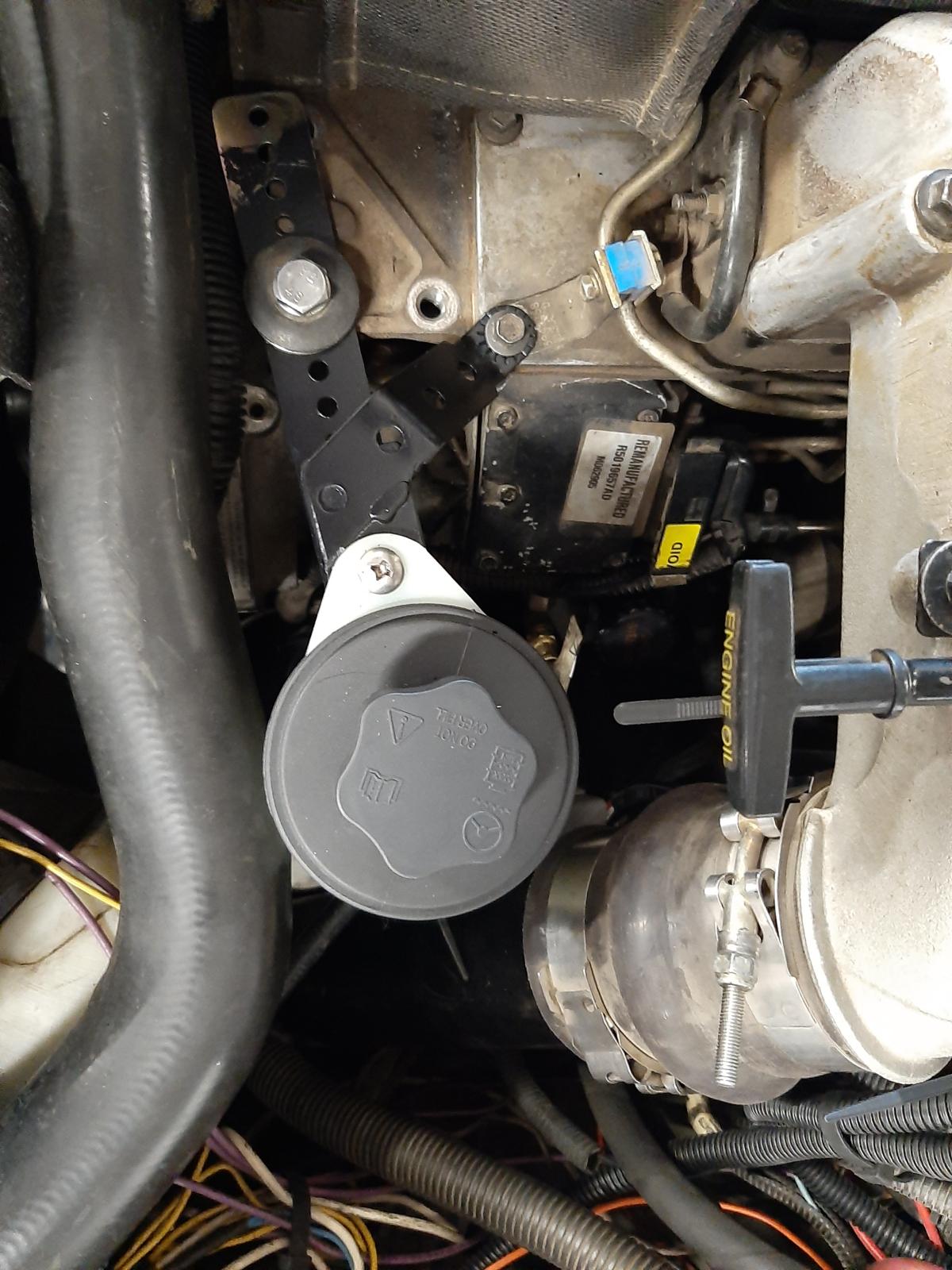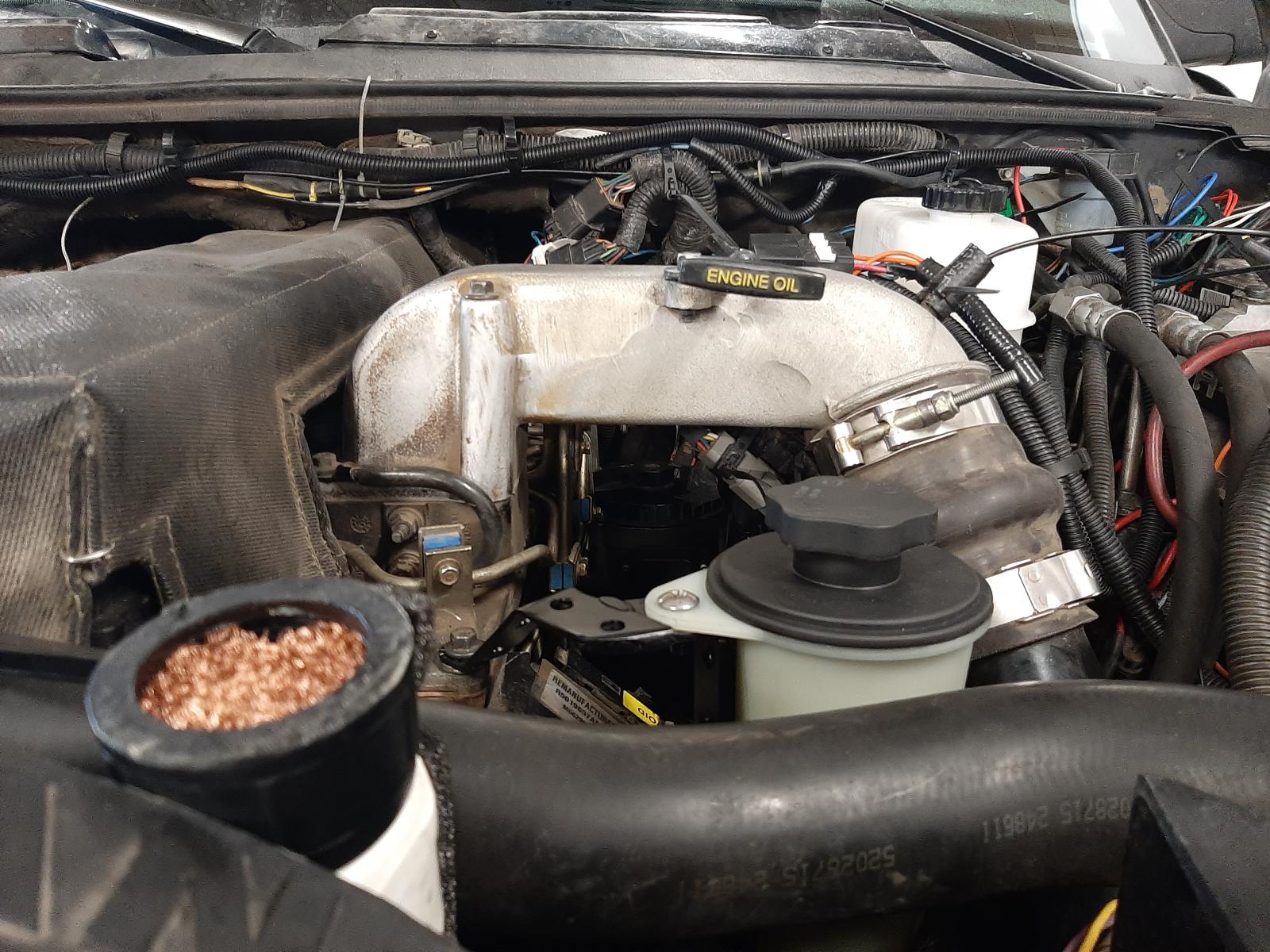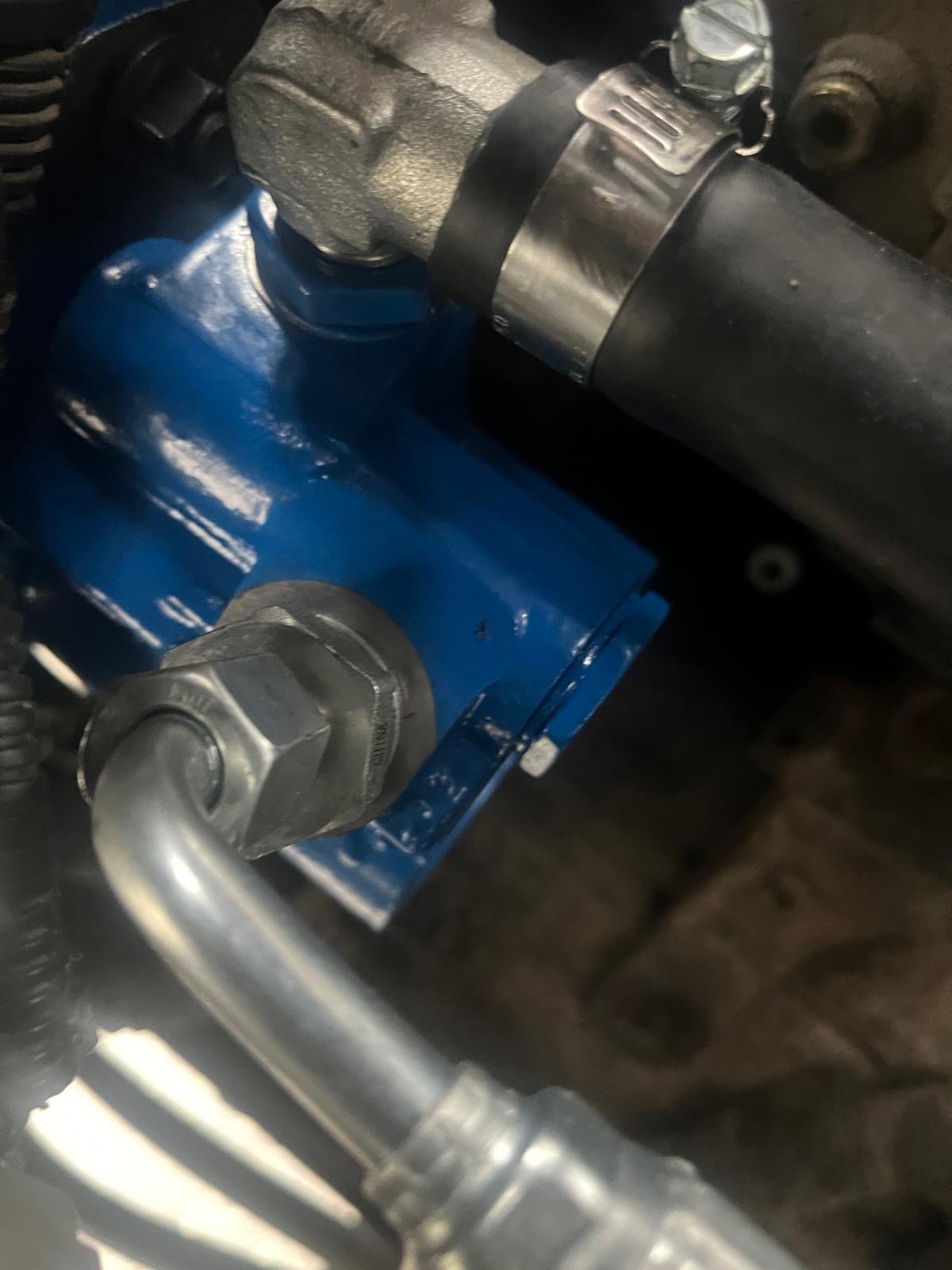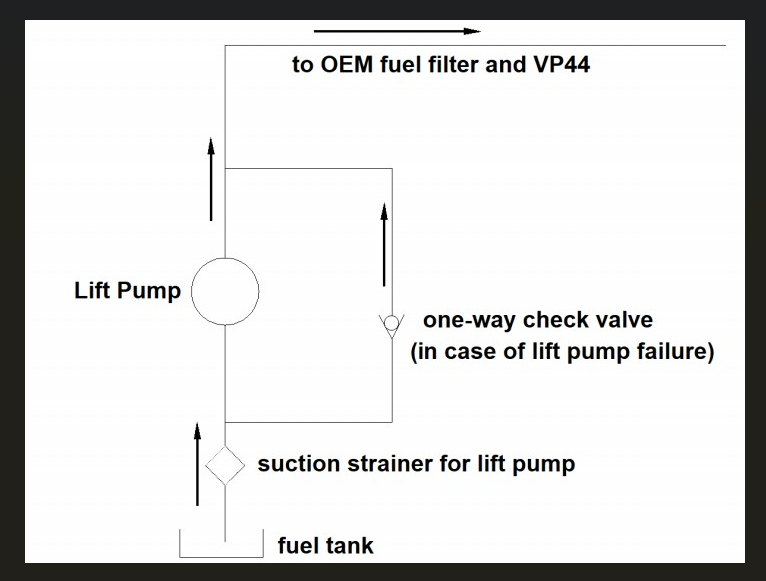
Everything posted by Tractorman
-
Last ditch attempt
@Chickendog73 , how old are your batteries, and are they in good condition? How about the crossover cable? John
-
Last ditch attempt
Good documentation on your part for your initial post regarding this problem. You definitely need to figure this out - you have a good truck with low miles. I don't know if you have a good wiring diagram for the engine controls, so I am posting a diagram below. I suspect that the collision with the rock wall is related to your symptoms. A couple of questions, though: Did the "stutter" show up right after the collision, or after the VP44 replacement? How much time and miles elapsed between the collision and the VP44 replacement? You mention testing the red / white wire from the PDC - I am assuming this is the wire that supplies power to the ECM and the injection pump. If so, I would continue to check voltage (engine running and voltage spikes occurring) downstream from there. As you can see in the wiring diagram, Joint Connector #2 (inside the PDC) and Splice #161 are part of that circuit. I would also verify the condition of ground Splice 168 to Ground 125 on front of engine. If you are using another ground connection point with your test lead and there is truly a ground problem in the ECM / injection pump circuit ground, you will get a steady voltage reading because you are bypassing the potential ground fault. Also, I believe there is one more splice that is not shown in the diagram - that would be S109 that is between S168 and G125. Are you familiar with the W-T ground reference modification? If so, has it been done? John
-
Working through miss/studder issues - codes 0237 & 0230
You can just swap out another like fuse and another relay and go for a quick test drive. John
-
Working through miss/studder issues - codes 0237 & 0230
There is a single connector with two black wires that are connected to the positive post of the driver side battery. These wires supply power to the intake manifold heaters (grid heaters). Within a few inches of the battery connection, you will see two fusible links - no fuses. Disconnect the the single wire connection. There are two fuse group locations. One is called the Power Distribution Panel (PDC), and the other is called the Junction Block. The PDC is located right beside the driver side battery. Th Junction Block is located on the left end of the dash. The driver's door must remain open for access. Hope this helps. John
-
Working through miss/studder issues - codes 0237 & 0230
Sounds like you are on the right track. The intake manifold heaters draw about 100 amps each - there are two of them. They are automatically in operation below 60°F ambient temperature. With the key on, engine off, the heaters are on while the "Wait to Start" lamp is lit. After the engine is started, the heaters post-cycle until a specific engine operating temperature is reached, or the vehicle speed reaches approximately 25 mph. The post-cycling current is higher than the alternator output, so it is normal to see the dash voltmeter drop significantly. This is why I recommend disconnecting the intake manifold heaters while diagnosing a low voltage electrical problem. John
-
Working through miss/studder issues - codes 0237 & 0230
I would be looking into this before doing any parts replacing. Was the intake manifold heater post-cycling when you were seeing the voltage drop on your test drive. If you are not certain, then I recommend to disconnect the intake manifold heater to simply troubleshooting the voltage drop. In normal operation, when the manifold heaters have finished their post-cycling, the voltage powering the VP44 should be steady around the 13.5 - 14.2 volt range. Steady is the key word. If the voltage continues to fluctuate wildly at the VP44, then you should check the power supply to the VP44, ECM and the PCM; but more importantly you should check that you have good operating ground circuits. John
-
Radiator Lifespan
I agree. John
-
Radiator Lifespan
@Mace , I think you saying that your are at 442,000 kilometers (275,000 miles) on your truck, currently? I know other people (not very many) that also have had the same long life on their injection pump. I'm at 402,000 miles on the truck with 315,000 miles (507,000 kilometers) on a replacement injection pump. The first pump was replaced under warranty at 87,000 miles. Also, a new in-tank lift pump was installed under the same warranty, even though the original lift pump was still in good working order. My replacement fuel injection pump operated with only 6 psi @ idle and 3 psi @ WOT from the in-tank pump for the first 150,000 miles. I replaced the in-tank lift pump with a used frame mounted FASS 65 gph lift pump - the in-tank pump was still fine, I just wanted the ability to do a road side repair if the lift pump failed. The used FASS pump is currently in use - 12 psi @ idle and 6 psi @ WOT. My replacement fuel injection pump has never received any two-stroke oil, nor any fuel additives, nor any other special attention. I have run the Smarty tuner on a mild tune for 150,000 miles, and RV275 hp injectors for 150,000 miles. John
-
Radiator Lifespan
Ok, What is the secret? John
-
Electric vacuum pump
He removed both units and installed a gear driven power steering pump directly onto the accessory drive gearbox. He also installed a remote power steering pump reservoir. Here is a link to his original post regarding the conversion. You will need to scroll through the whole post as he talks of other conversions, as well. I made the same conversion myself - very happy with the results. It's nice having an accessible see-through reservoir. The direct mount power steering pump definitely out performs any of my previous pumps, including the OEM pump. John
-
Front lower shock bolt size
That makes more sense. Since the sleeves have been loose for awhile, they probably have worn into the clamping "ears" of the mounting assembly. This will make it more difficult to achieve the right clamping force so that the steel sleeves don't move around after you install the new bolts. I recommend to closely monitor that clamping force for a few months after the truck is back on the road. John
-
Front lower shock bolt size
I am not understanding cause and effect here. Since the lower shock bushings have an inner steel sleeve that gets clamped tightly by the compression of the mounting bolt, there would never be any wear on the bolt. The only way that I can think of in which a shock bushing would be destroyed after 5 minutes of operation, would be that the incorrect shock absorber is being used (resulting in the lower mount receiving the full weight of the vehicle during compression, or the full weight of the axle assembly during a rebound). If you are getting aftermarket bolts, be sure the bolts have a hardness of 10.9. John
-
Front lower shock bolt size
Your truck: 2wd or 4wd? John
-
Help me build the perfect motor
My vacuum pump (a Dorman) is protected by a 15 amp fuse. The vacuum pump probably draws around 8 amps. John
-
ECM failure?
How are you checking voltage for the lift pump? Where are your test leads connected? Ignition key on - lift pump runs for 1/4 second Bump start, leave ignition key on - lift pump runs for approximately 20 seconds The ignition key must be turned off between bump start tests. John
-
Help me build the perfect motor
You may want to consider @Mace 's vacuum pump removal / direct mount power steering pump / remote reservoir conversion. The vacuum pump would be replaced by a small electric vacuum pump. I did this conversion myself and I a very happy that I did it. The best part of this conversion was a far better performing power steering pump, a see-through remote power steering reservoir that is very accessible, and the elimination of the gear-driven vacuum pump / power steering pump combination. I went one step further and remounted the APPS throttle control from the engine onto the brake booster / master cylinder mounts. The first two photos are my truck and the third photo is Mace's truck. John
-
NV4500 parts
I have no personal experience, but I have heard that Torque King is a good source. John
-
Do I need to bleed fuel system again?
If I am understanding correctly, the engine died because the lift pump was not operating. If this is true, then one of two things could be happening: The engine died because the VP44 internal vane pump could not pull fuel through a non operational lift pump. Some lift pumps are built this way, others have a directional free flow when non operational. The engine died because the VP44 internal vane pump was drawing air mixed with fuel from possible leaking fuel line / fuel line connections between the lift pump and the VP44 injection pump. I would be more suspect of #2 since you are seeing it take awhile to build lift pump pressure after the engine starts. I have actually installed a fuel line with a check valve that bypasses the lift pump just in case I have a lift pump failure. If a lift pump failure occurred on a road trip, the fuel supply would not be interrupted - the fuel would be drawn around the lift pump by the VP44's internal vane pump - no performance loss and no damage to the VP44. I could repair the truck when I get home. John
-
Do I need to bleed fuel system again?
It is likely that you still have air in the fuel system. Do you have an electric fuel pressure gauge? If so, is the sensor remotely mounted? If it is, then there will be trapped air in the line going to the remote mount. Eventually, this air will work itself out of the system. John
-
Radiator Lifespan
I replaced my OEM radiator in March of 2019 at 309,000 miles on the odometer. A small leak developed on the driver side where the upper part of the side tank connected to the core. I replaced the radiator with a Napa radiator - not sure of the brand, but the part number was 2464. Truck odometer is currently at 403,000 miles.
-
Flashing WTS light
Thanks for the update - will be following. John
-
Tracing disappearing oil
So, it seems that the turbo was the fix in your case. At least you got lots of life from the old turbo. Any performance difference noticed with the new turbo? John
-
BAM, VP44 may have bit the dust.
Sounds like you are enjoying your new truck. I imagine that the 8 spd transmission with good converter lock-up management and good shift quality would make it an excellent transmission for just about every type of driving situation. If the opportunity should arise, would you mind checking a couple of things and then reporting back? I am interested in how the torque converter lock-up responds under certain specific conditions. What is the lowest gear (in manual shift mode) that the torque converter will lock up and stay locked up with a working exhaust brake? Please give engine rpm and road speed. After defining that gear, will that gear still allow the torque converter to re-lock and the exhaust brake to re-engage, if the converter was unintentionally unlocked? If so, will the converter lock up without having to gain road speed to make it lock up. Does the torque converter lock-up and exhaust brake operate any differently when selecting specific gears in the tow-haul mode? These questions pertain to descending a long, steep down grade with 20 mph and 25 mph curves hauling a heavy load. I am going to be out of town for about four days, so I probably won't have internet access for immediate future replies. Thank you, John
-
Tracing disappearing oil
Thanks for the clarification. Still curious as to if you noted any restriction when you inspected the removed oily drain hose from the old turbo. John
-
Tracing disappearing oil
I always thought that the "W" is for internal waste gate - no "W", no internal waste gate. Am I wrong? Sounds like your project went well - let us know how the truck is doing in another 500 miles or so. I just crossed the 400,000 mile mark on my OEM HX35W, so I am interested to see if your engine oil consumption was for sure from the old turbo. The photo with the oily return hose - after removing that hose, could you tell if it was causing any restriction to flow? Thanks for posting your fix. John









